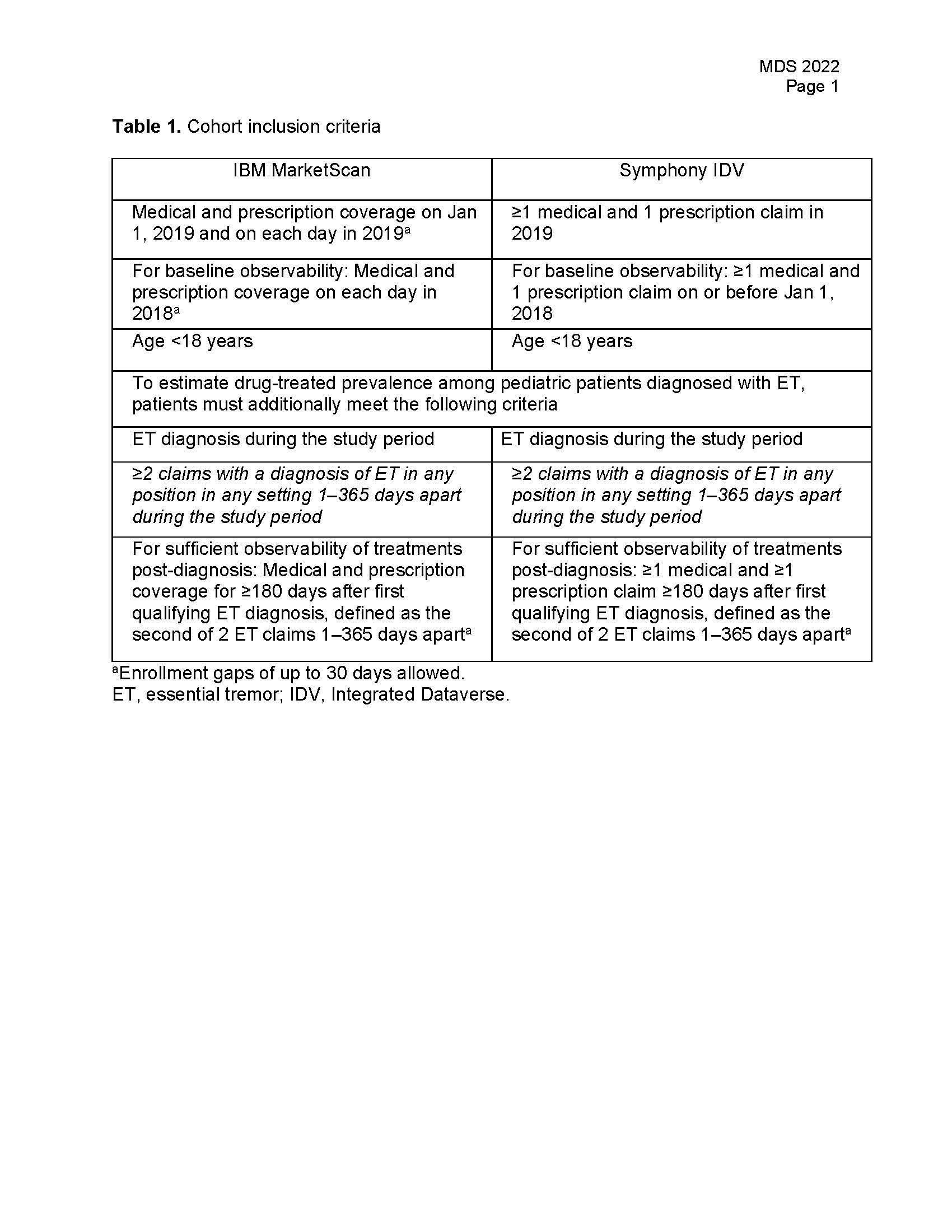Category: Tremor
Objective: Estimate the prevalence of diagnosed and drug-treated essential tremor (ET) in the pediatric population using 2 US healthcare claims databases.
Background: An ET diagnosis in children may represent early-onset familial ET, predominantly diagnosed through referral to tertiary centers. The prevalence of ET in pediatric patients is not well-understood.
Method: Two retrospective cohort analyses were conducted using the IBM® MarketScan® (IBM) and Symphony Integrated Dataverse (IDV®) databases (both 01/01/2016–12/31/2019) to estimate the number of US children (age <18 years) with ET. Inclusion criteria are provided in [table 1]. ET diagnosis was defined as 2 medical claims containing ICD-10-CM code G25.0 at least 1 day and ≤365 days apart. Drug-treated patients are defined as prevalent ET patients with ≥180 days of observability following the first ET diagnosis who subsequently received any ET medication in 2019. Age-adjusted (2019 US census data) prevalences were used to estimate the number of US children diagnosed and drug treated for ET.
Results: The estimated age-adjusted numbers (95% CIs) of patients diagnosed with ET in the US pediatric population were 8362 (7626–9230) and 6281 (5923–6629) using IBM and IDV, respectively. Among those, the estimated proportions (95% CIs) of pediatric patients with ET who were drug treated were 33.7% (28.7%–38.7%) and 38.1% (34.8%–41.3%), respectively. The estimated age-adjusted numbers (95% CIs) of patients with drug-treated ET in the US pediatric population were 2749 (2299–3238) and 2409 (2186–2655) using IBM and IDV, respectively. Beta-blockers (57% and 55% of patients, respectively) and anticonvulsants (36% and 44%, respectively) were the most common drug classes prescribed among treated pediatric patients. The most frequently prescribed drugs within those 2 classes were propranolol (55% and 52%, respectively) and topiramate (15% and 17%, respectively).
Conclusion: To our knowledge, this is the first study to measure ET prevalence in children using large healthcare claims databases. ET appears to be rare within the pediatric population. These data are consistent with the prevalence literature showing that ET is not as common in pediatric patients. The observed low drug-treatment rates are consistent with the slow, progressing nature of the disease.
To cite this abstract in AMA style:
R. Saad, M. Markowitz, L. Gibbs, D. F, W. Ni, R. Pahwa, K. Lyons, M. Baladi, J. Lin. Diagnosed and Drug-Treated Prevalence of Essential Tremor in Pediatric Patients: Retrospective Analyses of Two US Healthcare Claims Databases [abstract]. Mov Disord. 2022; 37 (suppl 2). https://www.mdsabstracts.org/abstract/diagnosed-and-drug-treated-prevalence-of-essential-tremor-in-pediatric-patients-retrospective-analyses-of-two-us-healthcare-claims-databases/. Accessed April 2, 2025.« Back to 2022 International Congress
MDS Abstracts - https://www.mdsabstracts.org/abstract/diagnosed-and-drug-treated-prevalence-of-essential-tremor-in-pediatric-patients-retrospective-analyses-of-two-us-healthcare-claims-databases/

